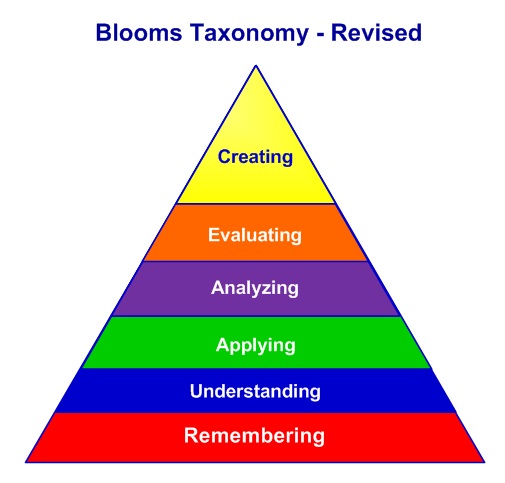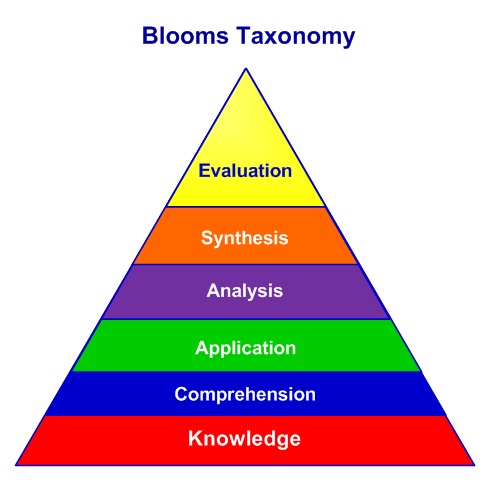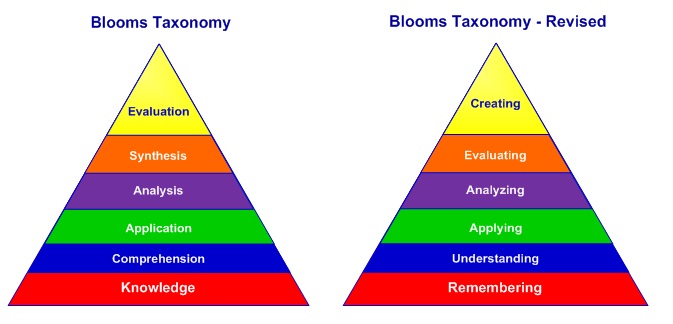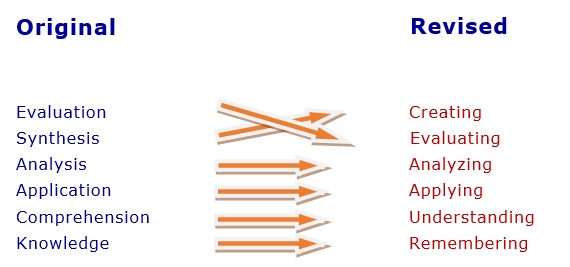Bloom’s Taxonomy – New Version
In 1956, Benjamin Bloom headed a group of educational psychologists who developed a classification system for levels of cognitive skills and learning behavior. The classification system they created is often referred to as Bloom’s Taxonomy. The word taxonomy means classifications or structures. Bloom’s Taxonomy classifies thinking according to six cognitive levels of complexity:
- Knowledge
- Comprehension
- Application
- Analysis
- Synthesis
- Evaluation
The categories are ordered from simple to complex and from concrete to abstract. The classification is often referenced as a progressive climb to a higher level of thinking with the highest level being “evaluation.”
The basic or lowest level in the taxonomy deals with simple knowledge acquisition. At this level, people simply memorize, recall, list, and repeat information. The cognitive complexity grows at every level. At the highest levels, people are able to build a mental structure from diverse elements and are able to put parts together to form a whole, as well as make judgments about the value of ideas.
Bloom’s Taxonomy Revised
During the 1990’s, Lorin Anderson and a group of cognitive psychologists updated the taxonomy. The revisions they made appear fairly minor, however, they do have significant impact on how people use the taxonomy. The changes can be divided into three categories: terminology, structure, and emphasis.
Changes to Terminology
The first thing most people recognize is the different terminology. The revised version changes the names of each of the six levels. For example, the lowest level of the original, “knowledge” was renamed and classified as “remembering.” It is also important to note the change from nouns to verbs to describe the different levels of the taxonomy. The names of the major cognitive process categories were changed to indicate action because thinking implies active engagements. Knowledge is an outcome or product of thinking, it is not a form of thinking. Consequently, since the word “knowledge” inaccurately described a category of thinking, it was replaced with the verb “remembering.”
Changes to Structure
The top two levels are essentially swapped from the old to the new version. This revised taxonomy moves the “evaluation” stage down a level and the highest element becomes “creating.” At the second to the highest level of the revised version, people defend, support, justify and evaluate their opinion on this information. And at the highest level, people generate new ideas, create a new product, or construct a new point of view. This change was made because the taxonomy is viewed as a hierarchy reflecting increasing complexity of thinking, and creative thinking (creating level) is considered a more complex form of thinking than critical thinking (evaluating level). A person can evaluate information without being creative, but creative thinking requires some level of evaluation or critical thinking (i.e. you need to evaluate the effectiveness of your new idea).
Changes in Emphasis
The revision emphasizes the use of taxonomy as a tool for alignment of curriculum planning, instructional delivery, and assessment. Additionally, the revision is aimed at a broader audience. The original taxonomy was viewed as a tool best applied in the younger grades at school. The revised version is more universal and easily applicable at elementary, secondary, as well as adult training.
The new terms are defined as:
| Levels | Description |
| Remembering | Retrieving, recognizing, and recalling relevant knowledge from long-term memory. This level is simply remembering or recalling previous learned information. |
| Understanding | Constructing meaning from oral, written, and graphic messages through interpreting, exemplifying, classifying, summarizing, inferring, comparing, and explaining. This is essentially demonstrating understanding of information by explaining ideas or concepts. |
| Applying | Carrying out or using a procedure through executing, or implementing. Basically, this is using the information in another familiar situation. |
| Analyzing | Breaking material into constituent parts, determining how the parts relate to one another and to an overall structure or purpose through differentiating, organizing, and attributing. |
| Evaluating | Making judgments based on criteria and standards through checking and critiquing. This includes justifying a decision or course of action. |
| Creating | Putting elements together to form a coherent or functional whole; reorganizing elements into a new pattern or structure through generating, planning, or producing. This includes generating new ideas, products, or ways of viewing things. |
Applying the Revised Version of Bloom’s Taxonomy
Just like the original taxonomy, the revised version provides a valuable framework for teachers, trainers, and instructional designers to use to focus on higher order thinking. By providing a hierarchy of thinking, both version can help in developing performance tasks, creating questions, or constructing problems.
Assessment of Learning Using the Revised Bloom’s Taxonomy
The following chart illustrates the level of thinking and the expectation of the learner at each level of the hierarchy. It helps gage if the learner can demonstrate his or her ability at that level.
| Levels | Measurement |
| Remembering | Can the learner recall or remember the information? |
| Understanding | Can the learner explain ideas or concepts? |
| Applying | Can the learner use the information in a new way? |
| Analyzing | Can the learner differentiate between the various parts or components or the whole? |
| Evaluating | Can the learner justify a position or decision? |
| Creating | Can the learner create a new product, generate a new idea, or create a different thought process? |
Moving to the Higher Order of Thinking
Below is an example of moving from the lower levels of the taxonomy to the higher levels as you teach a topic. Each level is built on the preceding lower level. As you move higher, each level becomes more challenging.
- Remembering: List different types of fruit
- Understanding: Explain why they are classified as fruits
- Applying: Diagram the parts of your favorite fruit
- Analyzing: Compare each fruit finding the characteristics that make it different from the others
- Evaluating: Determine and justify which fruits are the healthiest
- Creating: Create a drink using three fruits that would be considered extremely healthiest
Examples to Assess Mastery at Each Level
Below is a list of examples you can use to ascertain the level of mastery at each level.
Remembering
- Write the definition of a vocabulary word.
- List the parts of a bicycle.
- Name the main characters in the book.
- Name the counties in Africa.
Understanding
- Summarize the main idea of the story.
- Draw a picture showing the word’s meaning.
- Classify the parts of speech in the sentence given.
- Predict what will happen to the object when placed in water.
Applying
- Describe how you would use this net to catch fish.
- Write a sentence using three new vocabulary words.
- Apply the principles of learning to the workshop.
- Solve the problem using the concepts given.
Analyzing
- Compare how the climate is similar between two counties.
- Explain why the main character decided to make the decision she did.
- Determine which parts of the bicycle is most important.
- Research the best methods of removing stains from clothing.
Evaluating
- Explain the best alternative among the three choices.
- Determine which character in the stories was the most impacted by the events.
- Decide which parts of speech are most valuable to creating a sentence.
- Assess the value of the items on the table.
Creating
- Invest a device that can pick up small objects.
- Create a game that will help students learn vocabulary words.
- Write a story that leaves the reader in suspense.
- Generate three ideas on how to improve the learning process.
Bloom’s Taxonomy Revised – Action Verbs
The following chart provides action verbs for each level of the revised taxonomy. By creating learning objectives using these action verbs, you indicate explicitly what the learner must do in order to demonstrate learning.
| Levels | Action Verbs |
| Remembering | arrange, define, find, identify, label, list, match, name, memorize, recall, recite, repeat, state, tell, write |
| Understanding | classify, covert, conclude, demonstrate, describe, discuss, explain, identify, illustrate, locate, paraphrase, predict, recognize, report, select, summarize, translate |
| Applying | apply, choose, demonstrate, dramatize, employ, illustrate, interpret, modify, operate, produce, select, schedule, sketch, show, solve, use |
| Analyzing | analyze, appraise, categorize, classify, compare, contrast, criticize, differentiate, discriminate, distinguish, examine, experiment, question, outline, research, separate, subdivide, test, |
| Evaluating | appraise, argue, assess, choose, conclude, defend, estimate, evaluate, judge, select, support, value |
| Creating | assemble, construct, create, design, develop, devise, formulate, generate, integrate, invent |
Links
References:
Bloom, B. S. (1956). Taxonomy of Educational Objectives: The Classification of Educational Goals. Handbook 1; Cognitive Domain.
Overbaugh, R. & Schultz, L. “Bloom’s Taxonomy.”
Krathwohl, D. R. (2002). “A Revision of Bloom’s Taxonomy: An Overview.” Theory into Practice
Clark, D. (2010). Bloom’s taxonomy of learning domains: The three types of learning. Big Dog & Little Dog’s Performance Juxtaposition.
Anderson, L. W., & Krathwohl, D. (2001). A taxonomy for learning, teaching, and assessing: A revision of Bloom’s taxonomy of educational objectives.




